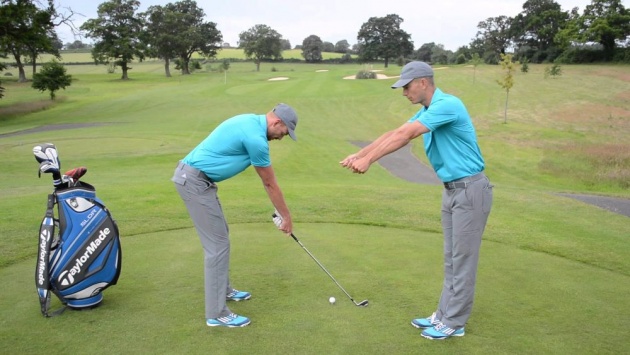Paganica, a game like modern golf, was played by the ancient Romans, who used a bent stick and a feather-stuffed ball. Later, the French and the Dutch played a game in which the ball, struck by a club, was aimed at an upright marker. The word 'golf' comes from the Dutch word golf (club).
Golf, as it is played today, has been traced back to the 14th-century Scotland. Scottish Golfers were the first to make holes in the ground and try to get the ball into the holes. Golf became so popular in Scotland by the middles of the 15th century that it was banned for a while. The Scottish King was afraid that it might place to archery, which at that time was important for defending the country. In the middle of the 19th century, golf spread from the British Isles to the United States. Today, it is played in the most countries. But the Royal and Ancient Club at St Andrews, Scotland, is recognized as the home of golf. Only St Andrews can decide on changes in the rules.
Golf is played on a specially prepared stretch of countryside known as a course. A course usually has 18 holes, although some small courses have only 9.
The game starts on a smooth, level oblong space called the teeing ground. The player hits the ball from the tee towards the cup, a round hole in the ground, 4 and 1/2 inches (11.4 centimeters) across and at least 4 inches (10.2 centimeters) deep. The distance from teeing ground to cup may vary 100 to more than 500 yards (90-460 meters). The point of the game is from the player to get the ball into the cup in a few strokes as possible.
Hockey is a sport for white men, basketball is a sport for black men. Golf is a sport for white men dress like black pimps.
-Tiger Woods-
PLAYING A HOLE
To get a good shot at the ball when driving it off, the player can put it on a wooden peg, or tee. A tee is like a cone turning upside down. It has a sharp lower end which is pushed into the earth. The top is slidably hollowed out so that the ball will rest on it. If he has no tee, the player can set his ball on a little mound of sand.
A definite route is followed in playing from tee to top. This route, a broad avenue of mown turf, is called the fairway. If the player's ball goes off one side of the fairway into tall grass or trees, he is said to be 'in a rough'. The ball is often difficult to play from here. A golf course has usually many obstacles, such as bushes, trees, streams, and hills. These add excitement to the game and challenge the golfer's skill. Sometimes artificial obstacles are made as well. A sand hole is called a bunker. Bunkers, ponds, and streams are known as hazards.
The only time during the game when the player may touch his ball is when he tees it up to drive off. After that, he must play the ball from wherever it lies and pay a penalty. The ball may be removed without penalty if it is lying on loose stones, leaves, twigs and the like. But anything fixed of growing near the ball cannot be moved, bent or broken off. The ball must be played around such objects as fenceposts, trees, and boulders. If the ball lands in a place where it cannot be hit, it may be picked up and dropped in another place where it can be hit, as long as it is no closer to the hole that it was before. The player must then add one to the number of strokes that he takes for the hole. If the ball comes to rest in a water hazard, it may be removed at the penalty of one stroke and played from behind the hazard or from the spot where the shot was first played. If a player cannot find his ball after five minutes of searching, the ball is said to be lost. He must add a stroke to the number for that hole and must put another ball in play at the point where the lost ball was hit.
After a few strokes, the player probably reaches the putting green, where the cup is located. The flagstick bearing the number of the hole is set in the cup but is removed when the player is on the green. The putting green is so named because only short strokes, or putts, are taken on its fine grass. The grass on the putting green is closely cut to make it as smooth as possible.
When the player finally puts the ball into the hole, he counts up the number of strokes it was taken him to get there. This is his score for the hole that is, the number of strokes from tee to cup. All strokes, including penalty strokes and those that barely touched the ball or missed it completely, must be included. The player then walks over to the next teeing ground and drives off to the next hole.
ALTERNATIVE FORMS OF MATCH PLAY
There is a format of match play called "Irish Match Play" in which 3 or 4 individuals may compete against each other. A points system is assigned where as an outright win a hole for a single player constitutes 2 points, a half of the hole or two or more players is equal to a single point. This format allows golfer to enjoy format of hole-by-hole match play in groups larger than 2 people.
Another alternative versions of single matchplay for more than 3 people is particularly more known as Rowan Matchplay. It begins with more participants playing against one another until one player wins a hole. That player is then one up versus all of their combined playing partners who now forms a team against the player leading and try to get the match back to all square. The player leadng at the end of 18 holes is the winner. For example, in a 3 player game, after someone goes 1-up, the match then takes the form of the leading player versus the scores of the two players.
Source: Wikipedia (Read More)
DRIVE, OR TEE SHOT
-
GRIP (OVERLAPPING) (1) Club rests diagonally across the left hand. (2) Right-hand grips with the thumb and first three fingers close to left hand. The little finger of the right-hand overlaps forefinger of the left hand.
-
(3) The "V's" of both thumbs and forefingers should point at the right shoulder.
-
(4) Underside view shows the little finger of the right hand overlapping the forefinger of the left hand.
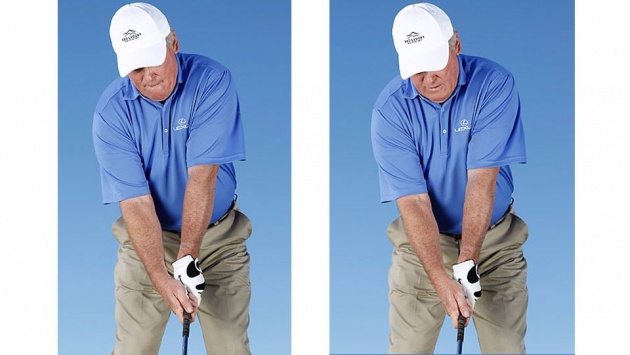
Image credit: GOLF.com
-
Get ready to overlap the ball.
-
(1) The stance is taken with feet approximately as far apart as the width of the shoulders. The ball is on a line with the heel of the left foot. (2) Top of the backswing emphasizes the straight left arm and right elbow close to the body. The club is horizontal. (3) At the finish of the swing, the player's right side is relaxed and the shoulders face the line of flight.
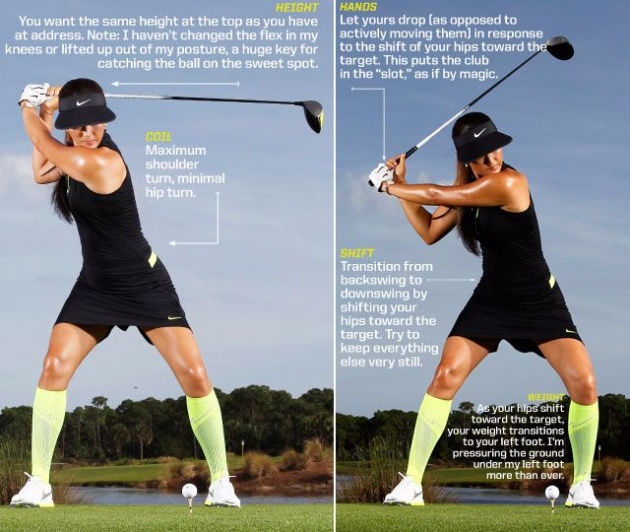
Image credit: GOLF.com
SCORING
A player's score at the end of 18 holes depends on his skill. A beginner may take more than 100 strokes to complex the course, and expert may finish the round less than 70. However, a player's score depends on the nature of the course as well as on skill. Some courses are quite easy to play since they have very few hazards. Other courses are difficult even for every good player. A score of 72 on some hard courses may be better than a 68 scored on an easy course.
Golf clubs recognize the differences between courses by setting up what is known as par for the course. Par is the number of strokes that an expert golfer should take if he plays each hole correctly and without mishap. From 70 to 72 is far for the average course.
Par is set up for each hole as well as for the entire course. For any given hole, par is generally three for any distance under 250 yards (229 meters). It is four for a distance of from 251 to 445 yards (230-407 meters), and five for distances over 446 yards (408 meters). A golfer may play a hole on par, or in one or more strokes above or under par. If he plays the hole in one stroke under par, he is said to have made a Birdie. He makes an eagle if his score is two under par for the hole. Up to this point, we have dealt with the scoring of a single player. When a golfer plays against one or more than opponents, there are various ways of scoring. In match play between two opponents, each hole must be counted separately. The player taking the least number of strokes for any single hole wins that hole. If both players take the same number of shots for the hole, the hole is said to be 'halved'. The match is halved when both players finish the game with the same number of holes to their credit. One or more extra holes must be played to decide which of the players has won the match.
During the match, the player in the lead is said to be 'one up' when he has won one more hole than his opponent, 'two up' when he has one two more. Sometimes the result of a match is in doubt up to the 18th and final hole. but the match may be decided earlier. If one player reaches a point where he is 'up' more holes than there are still to be played, he wins the game.
STANCE
1. DRIVE OR TEE SHOT-Slightly closed stance
Source of image: Youtube.com
2. NO.2 MEDIUM IRON- Square stance
3. SHORT IRON-Open stance

Source of image: golftipsmag.com
IRONS

Source of image: golftech.com
-
LONG IRON
-
SHORT IRON
*LONG-IRON ADDRESS - When using a long iron, stand straight with arms farther out.
*SHORT IRON- When using a short iron, stand close to the ball and bend over more.

First move: long iron and long iron address. Second move: short iron
Source of image: golf-for-beginners.blogspot.com
PUTTING
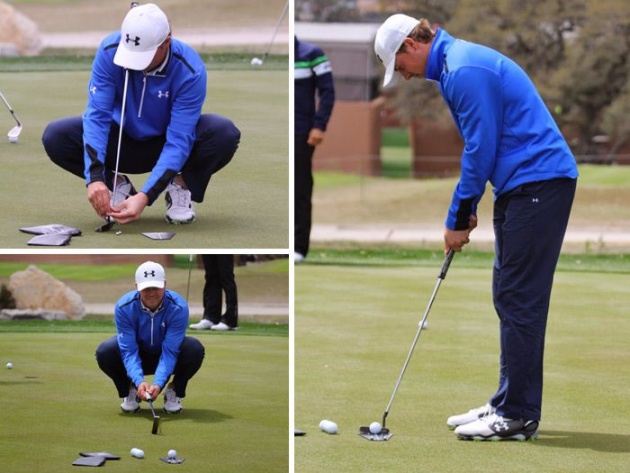
Source of image: golfwrx.com
THE DIFFERENT MATCHES
If two players compete with each other, the match is called a single. The players decide between themselves who is to drive off from the teeing ground of the first hole. The player who starts the game is said to 'have the honor'. After that, the player whose ball lies furthest from the hole has the honor and always plays his ball first.
The honor at each teeing ground after the first goes to the player who won the previous hole. If a hole is tied, the honor is given to the winner of the last hole that was not tied.
If two golfers play against another two, and each side plays one ball that match is called a foursome. Partners take it in turns to drive off at each hole. Sometimes two players play their better ball against the better ball of two other players. That is, each partner plays his own ball and the better score for that is made counts as the side's score that is made for that particular hole. Such a match is called a fourball match. Stroke (or medal) play is another form of golf. In stroke play, the golfer who completes the entire course in the last number of strokes is the winner.
Some golf tournaments are based on match play, others on stroke play. In match-play tournaments, the players are paired in a series of matches and the winners play each other. In stroke play, an agreed number of strokes are played.
The golf rules mentioned in this article are only the more important ones which a beginner should know. There are much more some of them quite complicated- which cover all sorts of situations that might arise during a game. As your interest in golf increases, you will want to learn all these rules. But knowing all the rules will not make you a good golfer. You must learn a great many different strokes.
REVERSE OVERLAP GRIP
- Left index finger overlaps fingers of right hand. Right foot serves as a prop. Eyes should be over the ball, which is played just in front of the left foot.
- The left hand guides the club, and the right hand strokes the ball.
- The putting blade must travel at an exact right angle to the line of the putt. Follow-through is important for a smooth stroke and accurate direction.
EQUIPMENT
A standard golf ball is made up of a long, thin strand of rubber wound round a central core of paste liquid in a rubber container. The markings of golf-balls-little circular dents called dimples or crisscrossed lines are like the feathers on an arrow. These help to keep the ball straight in flight.
There are several clubs, each designed for the special purpose. They come in two basic groups:
-
the woods- it is with wooden heads that are used for long shots.
-
the irons- with iron heads that are used for short shots for short distances.
The clubs are numbered within each group according to how far the hitting face of the head tilts back from the upright. The higher the number, the greater the tilt.
Example:
A number 1 wood is called a driver. The club used for short distances on the putting green is called a putter and is not given a number.
The rules limit a player to 14 clubs, and many golfers play with fewer. If you are a beginner, you will probably need only a driver, a putter, a number 2 wood and numbers 2, 5, and 9 irons. Other clubs may be added as you become more experienced.
CLUBS
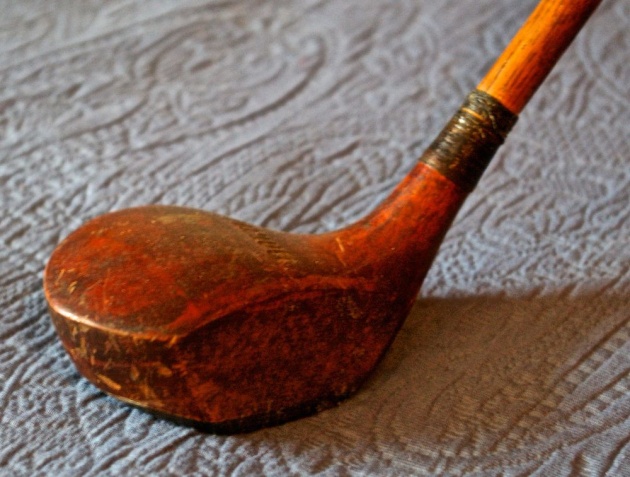
wooden clubs
Source of image: steverobert.wordpress.com

Source of image: honma.hk
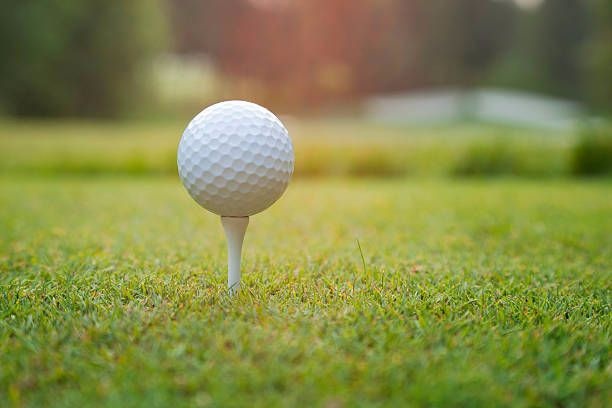
Tee and Golf Ball
Source of image: istockphoto.com
The driver is used to achieve the longest distances without hitting the ball high when driving it off from the tee. The driver's hitting-face has almost no loft-the angle from the upright that gives the ball height and distance. The number 2 wood is smaller than the driver and its face is slightly more angled, or lofted. It is used to send the ball higher on moderately long fairway shots.
Because of its still greater loft, the number 3 wood lifts the ball higher than the number 2 wood. It is sometimes used in short holes when a stroke with the driver might send the ball over and beyond the putting green.
Although the iron clubs look smaller than woods, they are really heavier. The number 2 iron is used for fairly long shots on the fairway- but short of the lengths that require a wood. The number 5 iron is a club with its face lofted enough to lift the ball into the air. This makes it stop rolling quickly after it lands. It is also good for raising the ball over hazards. The number 9 iron has a heavy head with an extremely lofted face that lifts the ball almost straight up. It is useful for getting out of a bunker or rough ground, or for any shot where height is needed. The putter is a short -shafter club. It's almost straight hitting-face is designed for rolling the ball over the ground. There are also other irons with different degrees of loft.
To become a master of the various strokes used in golf, it is best to take lessons from a good teacher. He can show by example just how each stroke should be made and can point out and correct any faults. It is also worth studying some of many books about golf that outstanding players have written.
All rights reserved. No part of this article
may be reproduced without special credits
in writing from the publishers in Wikipedia.com.

